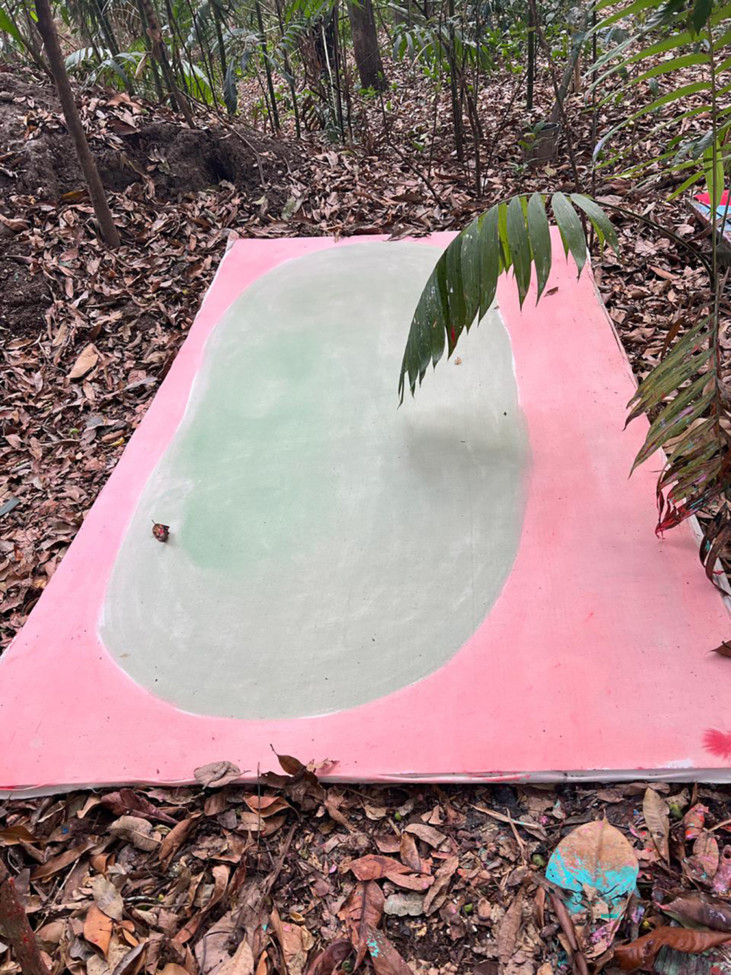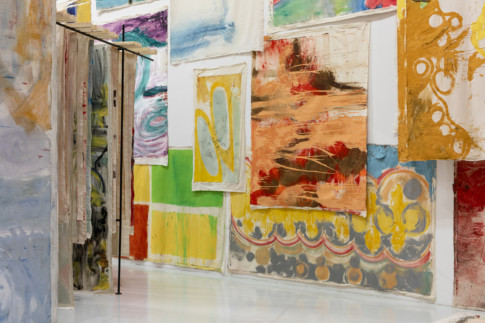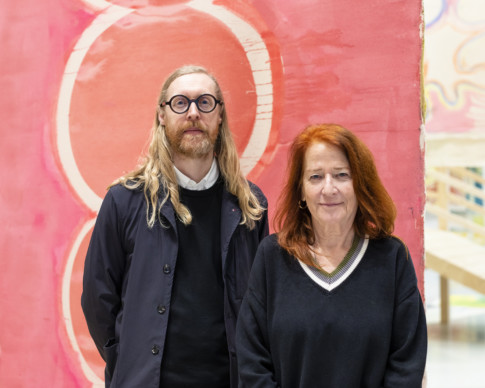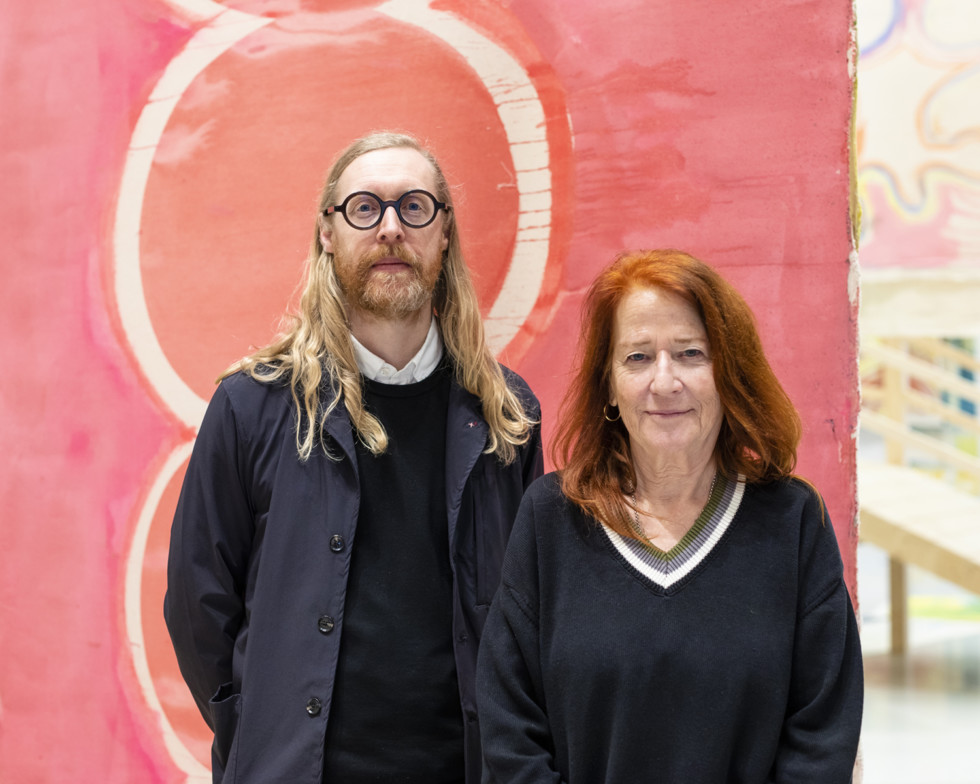
Vivian Suter with Curator Andreas Nilsson, 2025 Photo: Helene Toresdotter/Moderna Museet
Curator’s text about the exhibition
Entering into a Vivian Suter exhibition can be both bewildering and confounding as the multitude of paintings – over 350 in the exhibition at Moderna Museet Malmö – engulf you without a clear beginning or end. Yet if you allow yourself and your gaze to wander freely, you start to notice the colours, details, changes, overlapping. After a while your gaze sharpens. Parts of the suspended canvases bear traces of earth, leaves and branches. And in the seemingly abstract paintings, glimpses of motifs appear, like winding rivers, vegetation or a horizon. The works echo the seasonal and daily shifts in light and colour. Slowly, a non-hierarchical multifaceted installation emerges, where everything becomes one.

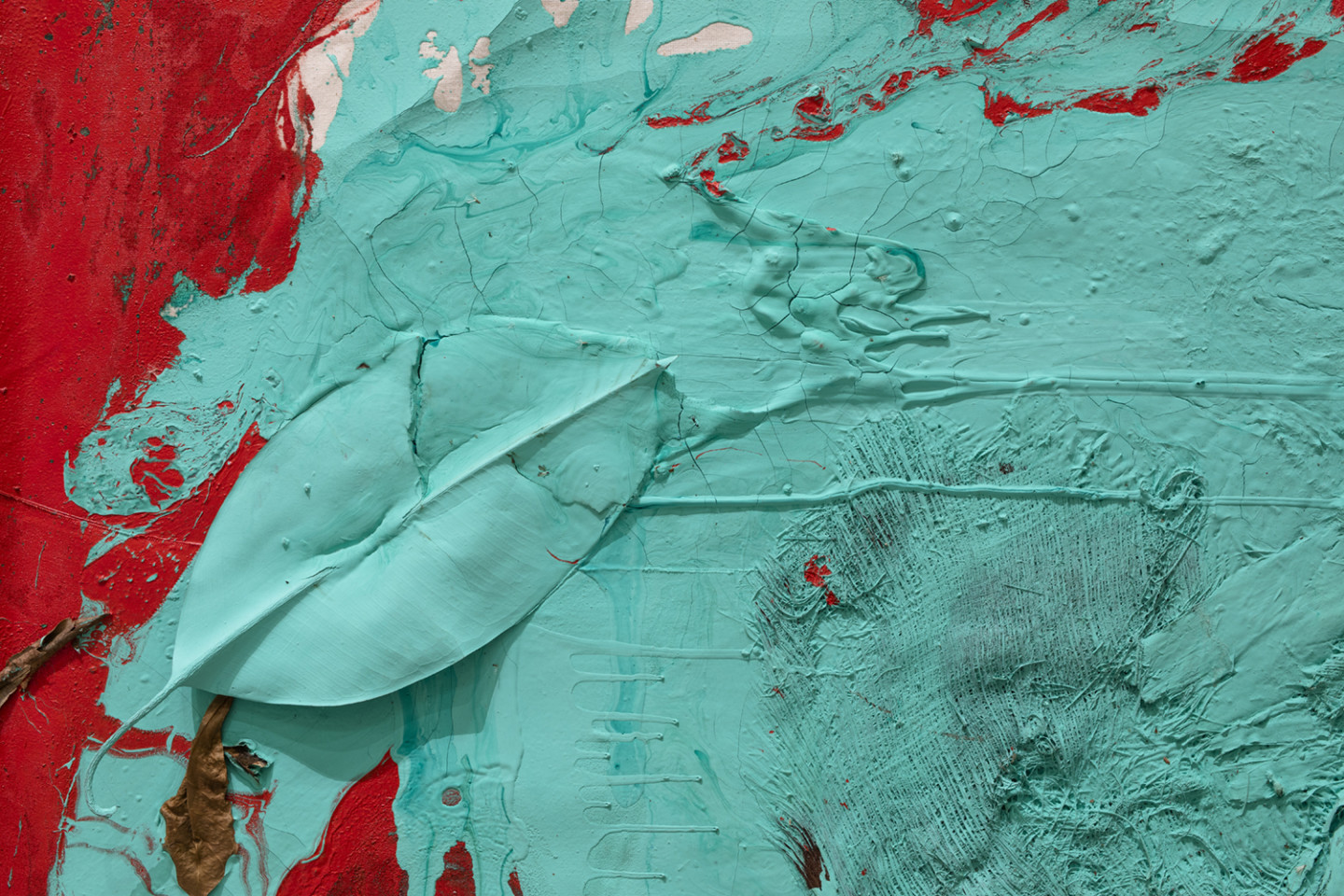
There is a tangible spontaneity and physicality in Vivian Suter’s paintings. The wild and the calm are in discourse with each other, creating a sense of movement. Seeing the work, be it individually or gathered in clusters in an exhibition, it is easy to imagine the active physical gesture in the moment of creation. Suter has said that it is like being in a state of trance when she paints. Conscious of her body, of course, but at the same time as if being in a different place. Hanging on the wall, suspended from the ceiling and lying on the floor the paintings overlap, and the front and back, even the spaces in between, emerge with the same power. The boundaries of the canvas do not exist. Neither is it always clear whether a canvas should be shown vertically or horizontally – the space and the context decide. Suter’s paintings, with few exceptions, are untitled and undated, which further emphasises the fleeting and interconnected feeling. All of this together creates a continually ongoing process of transformation. Suter herself expresses it best when she describes her work as part of a “lifetime painting”.
Vivian Suter has been living and working in Panajachel, Guatemala, for over 40 years. The village is on Lake Atitlán, about four hours’ drive from the capital Guatemala City. When I visit Suter in May/June, Panajachel is quite deserted, at least at the beginning of the week. But as the weekend draws closer, the streets, markets and bars become livelier. The climate is pleasant and one day I take an early morning walk down to the lake: in the haze, a hint of volcanoes can be made out on the opposite shore, towering 4,000 metres above sea level. Suter lives on the other end of Panajachel. After passing a couple of houses (Suter’s mother, the artist Elisabeth Wild, lived in the first one until she passed away in 2020), a large winding verdant garden gradually merges with wild nature. Leaf-strewn paths meander through the vegetation opening up to the occasional glade. The attentive eye will notice a fleck of paint on a leaf here, or an abandoned paint can there. This is Suter’s studio and place of work. The first thing she shows me is a fig tree that she fell in love with when she came here for the first time.
Vivian Suter is the daughter of two exiled Europeans. In the early 1960s, when Suter was about twelve years old, the family moved to Switzerland because of the unstable political situation in Argentina. She studied at the Art Academy in Basel, and participated in her first larger group show at Kunsthalle Basel in 1982. After travelling for a bit, she decided to settle in Guatemala the following year. Her move from Switzerland to Guatemala should not be interpreted as an act of protest in the same way as other artists have left the art world. Instead, it was perhaps more of a coincidence and necessity to land in a place that really spoke to her and where Suter was allowed to work undisturbed.
An exhibition of Vivian Suter’s paintings is like an extension, or abstracted version, of the surroundings where she lives and works. It’s private and personal, but never overly exposing. Instead, all it reveals is how important this place is to her, for her practice, for her well-being. Apart from the paintings, the exhibition at Moderna Museet Malmö also borrows other elements from Vivian Suter’s home environment. The metal stands used for the presentation are reminiscent of the way in which she herself stores her finished paintings waiting to be exhibited. A larger wooden structure that allows visitors to shift the perspective of the body and the gaze is also part of the exhibition. This allows the paintings placed on the ground, for example, to be seen from above. The structure is conceptually loosely based on the Greek architect Dimitris Pikionis’s (1887–1968) work with the landscape around the Acropolis in Athens. Pikionis designed a both personal and reverent area of paths and pavilions that blend seamlessly with the surroundings. Since Suter exhibited her work in Athens in connection with documenta in 2017, this city and this place mean a lot to her. And Pikionis’s subtle interventions in nature bring to mind Suter’s relationship with her surroundings and how she lets her work integrate with the environment.
Traces of leaves, sticks and rain water are mixed with often abstract shapes and gestures in both muted and bright colours. Suter lets the stretched canvases dry in her garden – they lie on her veranda or are hung between two trees, exposed to rain, sun and wind.

In private conversations, Vivian Suter speaks gladly and freely of her family – her son, her grandchild, her dogs who follow her everywhere. The exhibition title “I Am Godzilla” made me smile the first time I heard it. I struggle to see the connection between Godzilla – the prehistoric Japanese sea monster from popular culture that is reawakened through atom bomb tests in 1954 – and Suter’s exhibition. But for Suter it’s about a game between her and her grandchild, in which they playfully frighten one another with extended arms: “I am Godzilla!”. In the context it is interesting that Godzilla, both good and bad, defended his territory. The importance of place resurfaces, not just in Japanese pop culture, but also in the exhibition space. Suter generously leaves the door to her own safe space ajar and, in her own way, allows us to peak in and share in it.
Two events in recent years tend to be mentioned as extra meaningful for the development of Suter’s work – hurricanes Stan (2005) and Agatha (2010). These caused massive flooding and destruction, and many people died or disappeared. Suter’s house and studio were also damaged and her paintings were covered in clay and water. After some deliberation she decided to keep them, and retain the effects of nature on them. These traces were incorporated and became a part of the work. “I started to like how nature painted on them”, as she puts it.

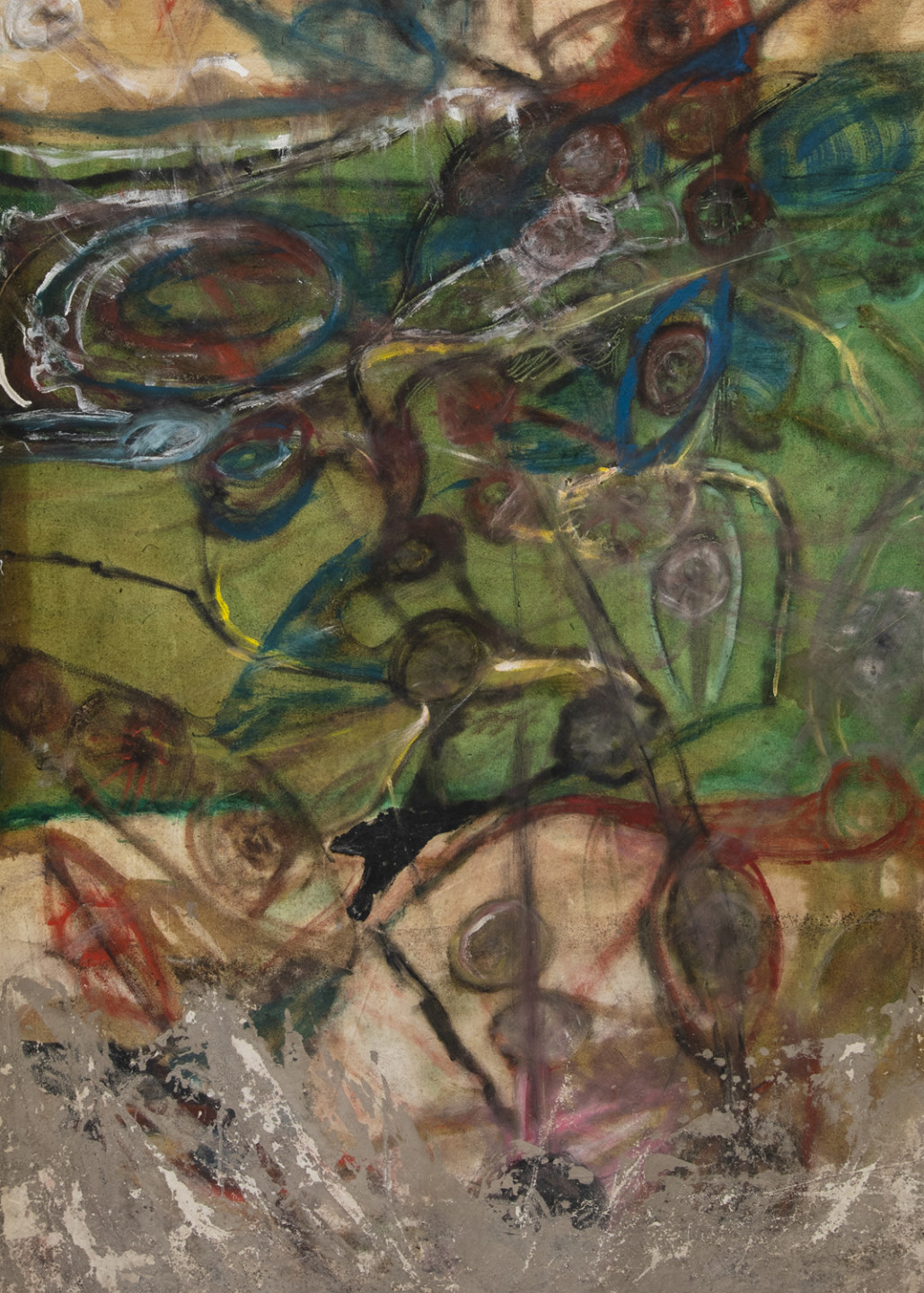
It is unmistakable how her house, her studio and the surrounding nature melt into one. Her work can be termed landscape painting in both the literal and conceptual sense of the term, since nature is absorbed into her paintings both as a motif and material. She uses oils and acrylics when she paints, but the list of materials also includes earth, botanical matter and jungle-based microorganisms. Traces of leaves, sticks and rain water are mixed with often abstract shapes and gestures in both muted and bright colours. Suter lets the stretched canvases dry in her garden – they lie on her veranda or are hung between two trees, exposed to rain, sun and wind. The works are created in close collaboration and dialogue with nature, accepting of its forces. The method of working freely outdoors also brings to mind early outdoor painting (en plein air), but Suter’s practice differs from, for example, the Impressionists. Her work is fleeting and mostly abstract, more personal and introverted, despite her ability to take in the environment. At times the abstraction is broken with representational motifs, the hint of a dog’s silhouette or a tree or vegetation. And although the works are undated, it is possible to imagine that certain paintings come from the same period, or even workday, considering their palette or motif.
A Vivian Suter exhibition is a sensory, site-specific experience in which time and place merge. The fact that circles are a recurring shape in her painting comes as no surprise. A shape without a clear beginning or end that is often found in nature. And despite the large number of paintings, a feeling of levity, fortuitousness and openness arises. There’s something meditative and repetitive in the blending of life, art and nature. At the same time, a distinct tenacity, perhaps even an obsession, emerges that also stresses that things have to be allowed to take the time they need.
Andreas Nilsson
Curator, Moderna Museet Malmö
Biography
Vivian Suter was born in Buenos Aires in 1949. Both exiled Europeans, her father owned a textile printing company in Buenos Aires, while her mother, Elisabeth Wild, was an artist. When Suter was twelve, the family moved to Basel, Switzerland, where she later studied painting. In 1982, shortly after her first large group exhibition at Kunsthalle Basel, she travelled through Latin America and settled in Panajachel, Guatemala, near Lake Atitlán, the following year.
“I am Godzilla” at Moderna Museet Malmö is Vivian Suter’s first exhibition in Sweden. It consists of more than 350 paintings, all untitled and undated. Several of the works have never been shown before.
Previous exhibition venues include: Kunstmuseum Olten, 2004, Kunsthalle Basel, 2014, São Paulo Biennial, 2014, documenta 14, Kassel and Athens, 2017, Power Plant, Toronto, 2018, The Art Institute of Chicago, 2019, Camden Art Centre, London, 2020, Museo Nacional Centro de Arte Reina Sofia, Madrid, 2021, Secession, Vienna, 2023, Museu de Arte, Arquitectura e Tecnologia Lissabon, 2024.
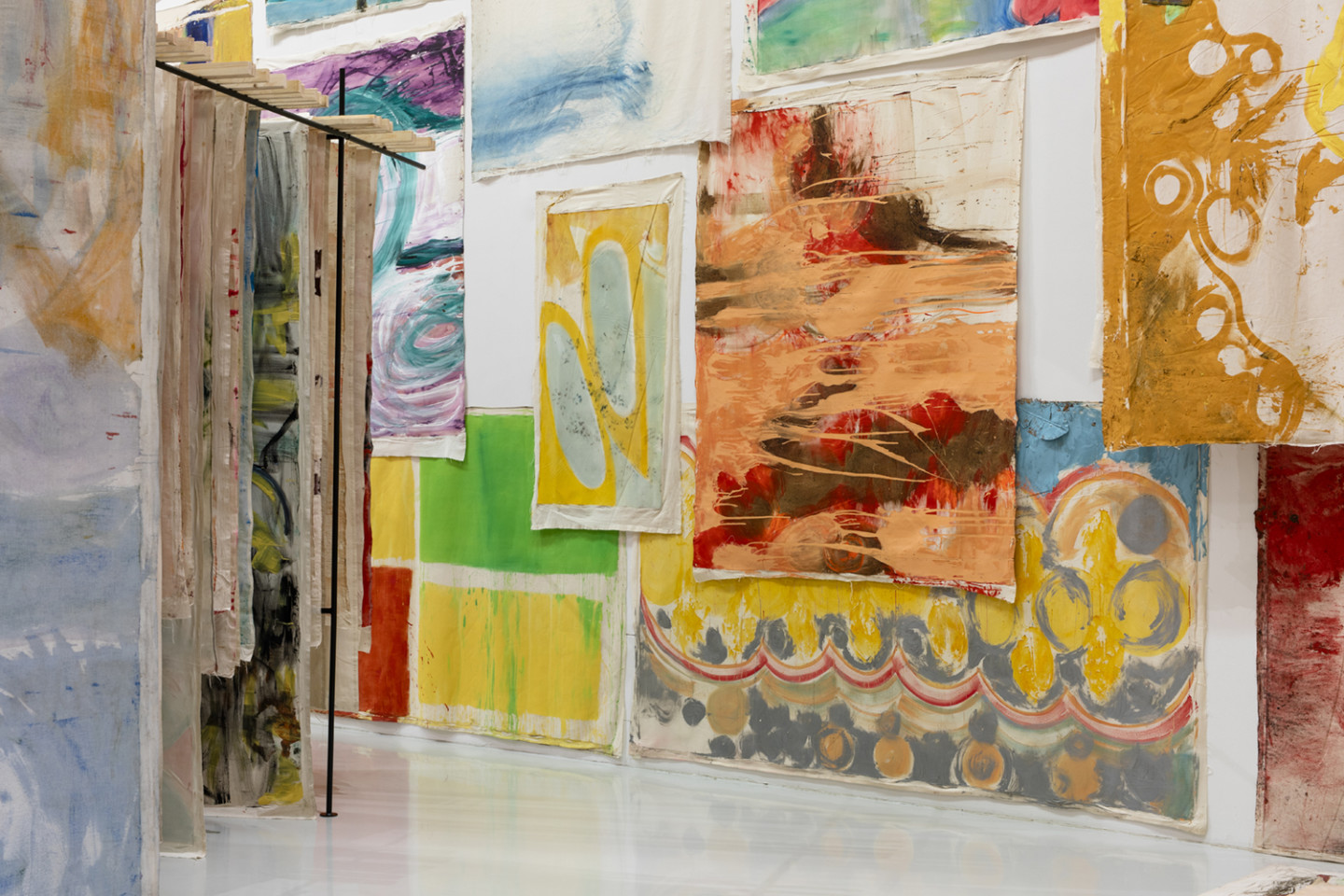
Vivian Suter
Vivian Suter, born in 1949 in Buenos Aires, Argentina, grew up in Switzerland and lives in Panajachel, Guatemala, since the early 1980s. The …
I am Godzilla
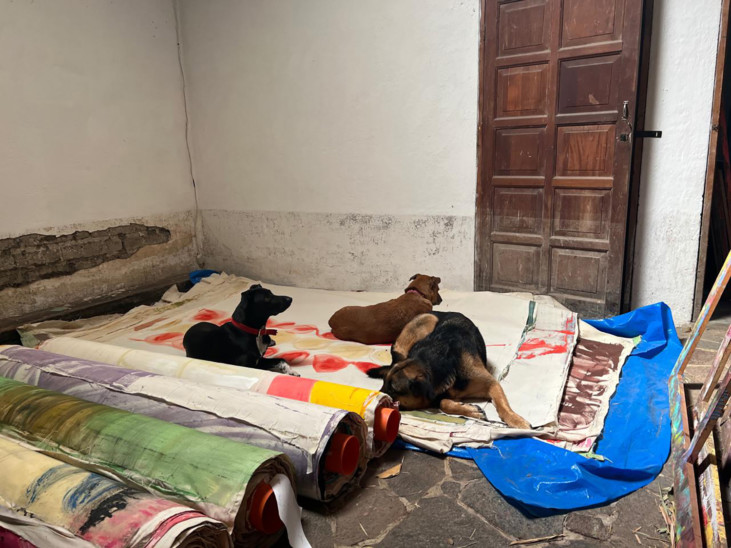
Curator’s tour: Vivian Suter – I Am Godzilla
Welcome to take part in the exhibition “Vivian Suter – I Am Godzilla” through a curatorial guided tour with Andreas Nilsson, curator …
Curator’s tour: Vivian Suter – I Am Godzilla
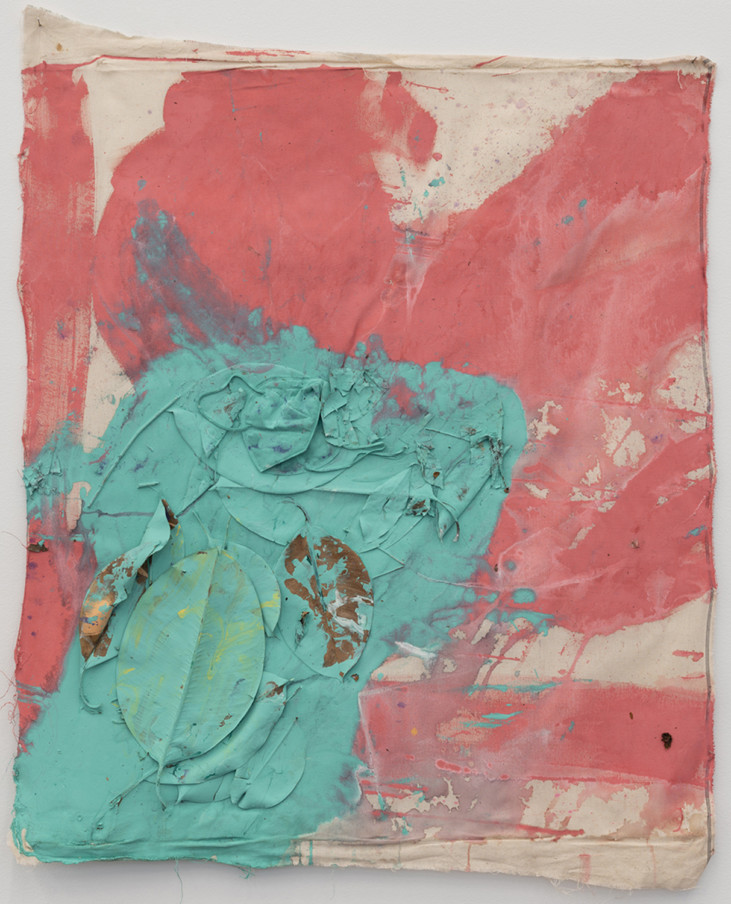
Vernissage: Vivian Suter – I Am Godzilla
Welcome to the opening and a preview of the exhibition “Vivian Suter – I Am Godzilla” displayed in the Turbine Hall. The artist is …
Join us for the opening!
